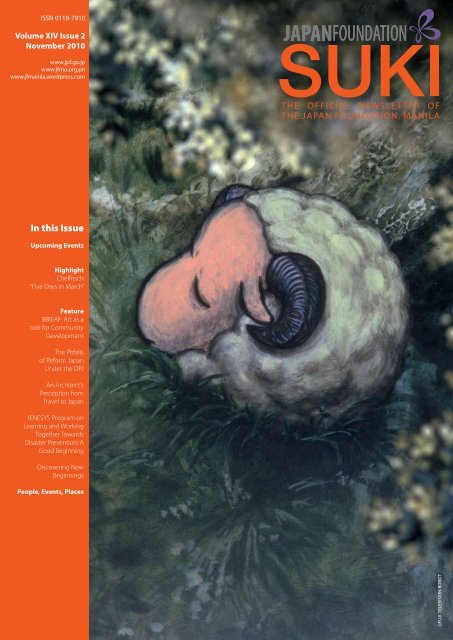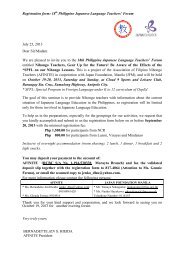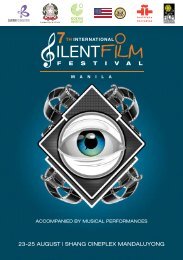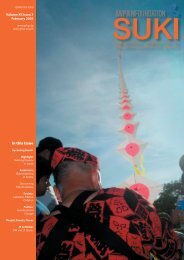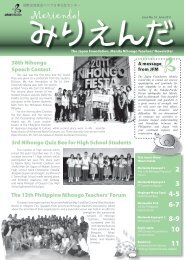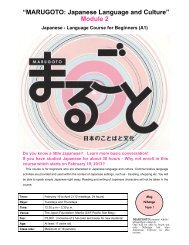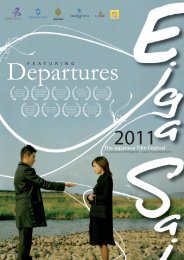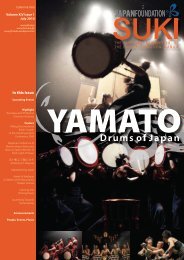In this Issue - The Japan Foundation, Manila
In this Issue - The Japan Foundation, Manila
In this Issue - The Japan Foundation, Manila
You also want an ePaper? Increase the reach of your titles
YUMPU automatically turns print PDFs into web optimized ePapers that Google loves.
ISSN 0118-7910<br />
Volume XIV <strong>Issue</strong> 2<br />
November 2010<br />
1<br />
www.jpf.go.jp<br />
www.jfmo.org.ph<br />
www.jfmanila.wordpress.com<br />
<strong>In</strong> <strong>this</strong> <strong>Issue</strong><br />
Upcoming Events<br />
Highlight<br />
Chelfitsch<br />
“Five Days in March”<br />
Feature<br />
BBIEAF: Art as a<br />
tool for Community<br />
Development<br />
<strong>The</strong> Pitfalls<br />
of Reform <strong>Japan</strong><br />
Under the DPJ<br />
An Architect’s<br />
Perception from<br />
Travel to <strong>Japan</strong><br />
JENESYS Program on<br />
Learning and Working<br />
Together Towards<br />
Disaster Prevention: A<br />
Good Beginning<br />
Discovering New<br />
Beginnings<br />
People, Events, Places<br />
©FUJI TELEVISION-ROBOT
2<br />
Upcoming Events<br />
2nd Philippine <strong>In</strong>ternational Cartoon,<br />
Comics and Animation Festival<br />
October 22 to 25, 2010<br />
SM City North EDSA, Quezon City<br />
(<strong>The</strong> Block, Annex and Sky Dome)<br />
University of the Philippines (Film Center)<br />
2nd PICCA Fest is the biggest cluster<br />
of events and organizations of content<br />
creators in the Philippines. <strong>The</strong> cluster of<br />
events include: <strong>In</strong>ternational Talks, Cartoons<br />
and Comics Exhibit, Animation Showings,<br />
Comic and Animation Competitions, Book<br />
Launches, PICCA Trade and Showcase,<br />
Workshops for Kids, etc.<br />
www.piccafest.com<br />
Chelfitsch “Five Days in March”<br />
November 5 to 6, 2010<br />
PETA <strong>The</strong>ater Center, Quezon City<br />
Chelfitsch is one of the most acclaimed<br />
phenomena in <strong>Japan</strong>’s theater scene in the<br />
last decade. Toshiki Okada, who formed<br />
the group in 1997, created the hybrid name<br />
from the English words “selfish” and “childish”<br />
which adequately describes how the group<br />
sees contemporary <strong>Japan</strong>ese society. Known<br />
for super-colloquial dialogue and sloppy<br />
gestures in everyday life, Chelfitsch has<br />
achieved wide acclaim in premier theater<br />
festivals and venues throughout Europe and<br />
Asia. <strong>The</strong>ir works include: On the Harmful<br />
Effects of Marijuana (Marijuana no Gai ni<br />
Tsuite); <strong>The</strong> End of Toil (Rouku no Owari) and<br />
Five Days in March (Sangatsu no Itsukakann),<br />
which has won many honors including the<br />
prestigious Kishida Kunio Drama Award<br />
(<strong>Japan</strong>’s Tony Awards).<br />
www.chelfitsch.net<br />
53rd Annual Philippine<br />
PEN Literature Conference<br />
December 4-5, 2010<br />
Montebello Vista Hotel, Cebu City<br />
<strong>The</strong> conference aims to gather Filipino<br />
writers and those from Asia-Pacific, the<br />
Middle East, Africa, Europe and the Americas<br />
and they will compose the six literary<br />
sessions. <strong>The</strong>y are to share excerpts from<br />
their recently completed work or work<br />
in progress, and talk about their literary<br />
concerns relevant to the theme.<br />
Ms. Nori Nakagami, a <strong>Japan</strong>ese novelist,<br />
will be participating as part of the panel<br />
on “Writing and Writers in Asia” within the<br />
conference theme : “Solidarity in Literature<br />
without Borders”<br />
Please contact the Philippine PEN c/o<br />
Solidaridad Bookstore (t/f # 63-2 - 525-5038)<br />
e-mail: philippinepen@yahoo.com<br />
<strong>Japan</strong>ese Language<br />
Proficiency Test<br />
December 5, 2010<br />
De La Salle University,<br />
<strong>Manila</strong><br />
University of San Carlos,<br />
Cebu City<br />
Mindanao Kokusai<br />
Daigaku, Davao City<br />
<strong>The</strong> JLPT is<br />
administered – worldwide, by the <strong>Japan</strong><br />
<strong>Foundation</strong> in cooperation with other<br />
cultural exchange/educational institutions,<br />
in order to evaluate and certify the <strong>Japan</strong>ese<br />
language proficiency of non-native speakers.<br />
<strong>The</strong> new test, which now comprises five<br />
levels (N1 to N5), will be held simultaneously<br />
in testing centers in <strong>Manila</strong>, Cebu City, and<br />
Davao City.<br />
A Gift of Jazz:<br />
Hiromi<br />
December 17, 8 pm<br />
Grand Sunset<br />
Pavilion, Sofitel<br />
Philippine Plaza<br />
<strong>The</strong> Philippine<br />
<strong>In</strong>ternational Jazz<br />
and Arts <strong>Foundation</strong><br />
in cooperation with<br />
the <strong>Japan</strong> <strong>Foundation</strong> bring to <strong>Manila</strong>, Ms.<br />
Hiromi Uehara for a one-night concert<br />
on December 17, 8:00 in the evening at<br />
the Grand Sunset Pavilion of the Sofitel<br />
Philippine Plaza.<br />
Hiromi Uehara first mesmerized the jazz<br />
community with her 2003 Telarc debut,<br />
Another Mind. Since then she has electrified<br />
audiences and critics of both hemisphere<br />
with a creative energy that defies the<br />
conventional parameters of jazz and<br />
pushes musicianship and composition to<br />
unprecedented levels of complexity and<br />
sophistication. Considered one of <strong>Japan</strong>’s<br />
best jazz pianist and composers, Hiromi has<br />
received numerous awards for her music<br />
including Jazz Album of the Year Award<br />
(2003); Horizon Award (2004); Album of the<br />
Year in Swing Journal’s 2005 Readers Poll and<br />
Best Jazz Act at the Boston Music Awards<br />
and the Guinness Jazz Festival’s Rising Star<br />
Award in 2006.<br />
<strong>The</strong> event is also sponsored by Yamaha,<br />
Delta Airlines and Sofitel Philippine Plaza<br />
<strong>Manila</strong>.<br />
JFM on Facebook tm and Twitter tm<br />
<strong>The</strong> <strong>Japan</strong> <strong>Foundation</strong>, <strong>Manila</strong> has joined<br />
in on the social revolution! Get the<br />
latest updates on events by liking us on<br />
Facebook or following us on Twitter @<br />
jfmanila.<br />
Monthly Oshaberi Salon – Let’s Talk in<br />
<strong>Japan</strong>ese @ JFM Library<br />
Brush up on your Nihongo and talk about<br />
<strong>Japan</strong>ese language and culture with<br />
our JENESYS “Young <strong>Japan</strong>ese Teachers.”<br />
Everyone is welcome to join! For schedule<br />
inquiries, contact the <strong>Japan</strong> <strong>Foundation</strong>,<br />
<strong>Manila</strong> at 811-6155 to 58.<br />
Editorial Staff<br />
Shuji Takatori<br />
Editor-in-Chief<br />
Yukie Mitomi<br />
Associate Editor<br />
ISSN 0118-7910<br />
Volume XIV <strong>Issue</strong> 2<br />
November 2010<br />
Suki is a newsletter published by <strong>The</strong> <strong>Japan</strong> <strong>Foundation</strong>, <strong>Manila</strong><br />
(JFM) located at the 12th Floor, Pacific Star Building, Sen. Gil<br />
Puyat Avenue, cor. Makati Avenue, Makati City 1226, with<br />
telephone numbers (632) 811-6155 to 58, fax number (632)<br />
811-6153; and email address at email@jfmo.org.ph.<br />
Suki is published three times a year and is duly registered as<br />
printed matter mail at the Makati Central Post Office under<br />
Permit No. 1074-97 NCR dated June 16, 1997. It is distributed<br />
free of charge to individuals and organizations interested in<br />
<strong>Japan</strong>ese Studies and <strong>In</strong>ternational Culture Exchange.<br />
Cecilia EJ Aquino<br />
Sheila de la Paz<br />
Katrina Soliman<br />
Roland Samson<br />
Staff<br />
©FUJI TELEVISION-ROBOT<br />
<strong>The</strong> opinions expressed in the feature articles are of the authors<br />
and not necessarily of the <strong>Foundation</strong>. Reproduction in whole<br />
or part of Suki articles is prohibited without permission from<br />
the author and <strong>The</strong> <strong>Japan</strong> <strong>Foundation</strong>, <strong>Manila</strong>.
Farewell / Welcome Greetings<br />
3<br />
Dear Friends,<br />
As they say, “all good things must end someday…” <strong>this</strong> is to wish you farewell as I have<br />
to leave the Philippines for a new assignment at the <strong>Japan</strong> <strong>Foundation</strong> Headquarters in<br />
Tokyo.<br />
My tour of duty in the Philippines was of significant importance as I had been a witness of<br />
national historical events that have been professionally rewarding; personally enriching, it<br />
was as well, since it was a great pleasure to have lived in a country that served as a “home<br />
away from home” for me and my family for the past five years.<br />
I feel that I am bound to pursue an upscale dynamic career after spending the best<br />
moments of my life in the Philippines. I am very lucky to be able to keep close contact<br />
with the Philippines in my new assignment and with a lot of Filipinos whom I have<br />
strengthened bonds of friendship with. I personally hope to reciprocate in my own humble<br />
way my “Utang na loob”.<br />
Mabuhay for everyone,<br />
Ben SUZUKI<br />
Director<br />
JF <strong>Japan</strong>ese Language Course Team<br />
Teacher and <strong>In</strong>stitutional Support Dept.<br />
<strong>Japan</strong>ese-Language Group<br />
Warmest greetings to everyone!<br />
Upon my arrival at the NAIA last month, I was quite surprised that the climate<br />
<strong>In</strong> <strong>Manila</strong> was cooler than that in Tokyo. I first thought that it was some kind of an<br />
“invigorating breeze of friendliness” welcoming me in the Philippines. However, soon<br />
enough, I realized that it must have been only the unusually hotter and more humid<br />
weather in Tokyo that made me feel so. Nevertheless, I can assure you that whatever<br />
weather extremities there might be – I will certainly survive. I am very glad to have been<br />
assigned as the new Director of <strong>The</strong> <strong>Japan</strong> <strong>Foundation</strong>, <strong>Manila</strong>.<br />
Since its establishment in 1996, <strong>The</strong> <strong>Japan</strong> <strong>Foundation</strong>, <strong>Manila</strong> has conducted various<br />
kinds of cultural activities including performing arts, visual arts, films, publication,<br />
<strong>Japan</strong>ese Language, exchange of persons, <strong>Japan</strong>ese Studies, and intellectual exchange.<br />
I will definitely continue these activities, and I will cooperate strongly with other cultural<br />
institutions and partners so that we can have an “exuberant breeze” of concerted efforts<br />
to create new types of projects for a more effective and efficient implementation, such<br />
as the ones on global issues and multilateral relationships.<br />
I am earnestly looking forward to meeting you all soon!<br />
SHUJI TAKATORI<br />
Director<br />
<strong>The</strong> <strong>Japan</strong> <strong>Foundation</strong>, <strong>Manila</strong>
4<br />
HIGHLIGHT<br />
<strong>The</strong> performances of chelfitsch employ<br />
rambling dialogue that often sounds<br />
like private mutterings and a “noisy” style<br />
of physical expression that has also been<br />
recognized as contemporary dance, to<br />
depict the elusive and nondescript state of<br />
today’s young people in <strong>Japan</strong>ese society.<br />
Since being invited to Belgium’s Kunsten<br />
Festival des Arts and coming to the<br />
attention of the world’s festival directors<br />
in 2007, chelfitsch has been increasingly<br />
active on the international scene. To<br />
date, its representative work, Sangatsu<br />
no Itsukakan (Five Days in March) has<br />
been performed in 14 cities in nine<br />
countries and its director Toshiki Okada<br />
and his group members have created new<br />
works jointly with international festivals<br />
and toured overseas. <strong>The</strong>se efforts and<br />
opportunities have brought about a<br />
search for environments to enable further<br />
artistic experimentation.<br />
Chelfitsch<br />
“Five Days in March”<br />
Photo courtesy of Toru Yokota
HIGHLIGHT<br />
5<br />
Photo courtesy of Toru Yokota<br />
Sangatsu no Itsukakan<br />
(Five days in March) –<br />
Toshiki Okada<br />
On March 21 (20th in U.S. time), 2003,<br />
the U.S. armed forces began bombing Iraq.<br />
This play tells about the actions of a few<br />
young couples during a period of five days<br />
spanning the two days prior to and two<br />
days after <strong>this</strong> date. What makes <strong>this</strong> play<br />
unique is that the actions of the young<br />
people are literally “told” rather than being<br />
“acted out” by the actors.<br />
One of couples had just met at a<br />
live performance club in Roppongi and<br />
ended going straight from there to a love<br />
hotel in Shibuya, where they spent five<br />
days. Going out to eat from time to time,<br />
the couple Minobe and Yukki suddenly<br />
find that they are seeing Shibuya with<br />
fresh new eyes. <strong>The</strong>n there is Minobe’s<br />
friend, the slightly wired girl Miffy and the<br />
boy Azuma who she meets at a movie<br />
theater. <strong>The</strong>re are also the two young men<br />
Yasui and Ishihara who are taking part,<br />
somewhat half-heartedly, in an antiwar<br />
march in Shibuya.<br />
<strong>The</strong> play’s style is one in which the<br />
seven actors come on stage as “Actor 1”<br />
and “Actor 2” and proceed to take turns<br />
telling the audience the stories of the<br />
characters of the play as if they had just<br />
heard the stories from the characters<br />
themselves. For example, here is what one<br />
of the actors says: “OK. I guess I’ll begin<br />
telling the story of Five Days in March<br />
starting with day one. First of all, I think<br />
we’ll say <strong>this</strong> is set in March of last year and<br />
it’s the story of <strong>this</strong> guy named Minobe<br />
who wakes up one morning and realizes<br />
he’s in a love hotel and he’s like ‘Hey, I’m<br />
in a love hotel’ and, not only that, there’s<br />
<strong>this</strong> girl who’s like asleep beside him and<br />
he’s saying ‘I don’t know <strong>this</strong> chick’.” <strong>In</strong> <strong>this</strong><br />
way, the actors don’t play the roles of the<br />
characters but simply relate their actions<br />
to the audience.<br />
This work, which has no real plot<br />
or notable incidents occurring, is an<br />
attempt at a serious exploration of<br />
“present expression.” First of all it removes<br />
the deceptive theatrical element of how<br />
skillfully actors can “act out a role,” and<br />
then it tries to eliminate the artificiality<br />
that always exists to some degree in lines<br />
spoken by the actors when they are clearly<br />
from a drama-like script.<br />
As a work born at the end of a<br />
quest for the most sincere form of<br />
expression in the present, Five Days in<br />
March skillfully juxtaposes the grand-scale<br />
event of “War” and what can be called the<br />
almost insignificance of real daily life, to<br />
succeed beautifully in giving form to the<br />
ungraspable sense of the present held by<br />
<strong>Japan</strong>ese young people.<br />
Source: Performing Arts Network <strong>Japan</strong> (www.performingarts.jp)
6<br />
FEATURE<br />
BBIEAF:<br />
Art as a tool<br />
by Joaquin Gasgonia<br />
Palencia, MD<br />
Executive Director<br />
and Founder of BBIEAF<br />
for Community<br />
Development<br />
<strong>The</strong> large-scale bamboo installations on Bagasbas Beach in Daet, Camarines Norte, Philippines are<br />
but ephemeral tangibles of a life-changing event that occurred here from May 30 to June 6, 2010.<br />
Under the summer sun, six artists from all over the world, namely, Mia Orsag from Croatia, Stuart<br />
Ian Frost of the UK, Tanya Preminger of Israel, Emmanuel Herbulot of France, Irma Lacorte of the<br />
Philippines and Chak Chung Ho of HK SAR China immersed with members of six small communities<br />
in a collaborative Art-making activity designed to acquire new knowledge, change perspectives,<br />
initiate partnerships and create the first steps toward more concrete interventions to alleviate poverty<br />
and raise standards of living in the new traditions of environmental sustainability and responsible<br />
and empowered citizenhood.<br />
<strong>The</strong> 3rd Bagasbas Beach <strong>In</strong>ternational Eco Arts Festival (www.bbieaf.org) was initiated in 2003 by<br />
the Our Lady of Lourdes College <strong>Foundation</strong> (www.ollcf.org) in its search for new avenues to address<br />
chronic socio-developmental problems that have proven resistant to resolution using traditional<br />
methods. <strong>The</strong> theme for the 2010 BBIEAF was Art+Environment+Sustainability, which meant using<br />
Art as Tool for Human and Community Development. Realizing that any intervention would be useless<br />
unless it emanates from the stakeholders themselves, the festival focuses on changing perspectives<br />
and attitudes of the target populations, and empowering them so that they could both think up of<br />
the solutions as well as create the tools to realize them.<br />
From its previous stagings in 2003 and 2008, the 3rd BBIEAF has evolved to include more tools<br />
in its developmental arsenal. For one, a video art festival was included to further push the aims of<br />
the festival by using a medium that has traditionally been close to the Philippine community’s heart<br />
– cinema. Using a familiar medium for delivering catalytic learning opportunities makes it an easier<br />
task to get across to the target stakeholders. <strong>The</strong> eminent <strong>Japan</strong>ese video art pioneer, Takahiko Iimura,<br />
who graciously accepted curatorial duties for <strong>this</strong> program, was honored with a mini-retrospective of<br />
Photo courtesy of BBIEAF
7<br />
Photos courtesy of BBIEAF<br />
his works over 5 decades. He also brought<br />
with him some of the best works from a<br />
new generation of <strong>Japan</strong>ese video artists<br />
from Video Tokyo.<br />
<strong>The</strong> video art program was shown in<br />
the public areas in and around the town<br />
of Daet – the OLLCF Campus, department<br />
stores, malls, public markets, restaurants,<br />
as well as the exterior walls of large<br />
buildings.<br />
This program, aside from the Curator’s<br />
Selection and the Iimura Mini-retrospective,<br />
consisted of video artists from Germany,<br />
USA, France, Iraq, Italy, Canada, Spain and<br />
<strong>Japan</strong>.<br />
<strong>The</strong> Public Art program, curated by<br />
Benjamin Edward Hughes II, resulted in two<br />
outdoor benches on the OLLCF campus by<br />
Jerusalino Araos of the Philippines and Tets<br />
Ohnari of <strong>Japan</strong>.<br />
It is the expressed goal of the OLLCF<br />
to input Art into the everyday life of<br />
its students and faculty members to<br />
inculcate its inherent qualities of creativity,<br />
innovativeness and superior technical<br />
skills.<br />
Thus, the 3rd BBIEAF was held with<br />
three major programmes – installation,<br />
video art and public art – all designed<br />
to transfer both contents and methods<br />
of superior processual interaction which<br />
consisted of new knowledge and transcultural<br />
perspectives as well as new<br />
mental techniques and points of view. All<br />
of these are designed to inject changes in<br />
the way some of the most impoverished<br />
people in the country view their problems,<br />
their situation, and the new tools which<br />
they can utilize to make changes that<br />
will alleviate their own conditions. <strong>In</strong> the<br />
light of the chronicity of poverty and the<br />
culture of helplessness in the country, the<br />
BBIEAF seeks to empower the stakeholders<br />
by giving them the mental postures<br />
needed to rise beyond the despair and<br />
frustration and to see that a better future<br />
is actually within their grasp with the right<br />
knowledge, attitudes and practices.<br />
Alongside the BBIEAF, the Center<br />
for Empowered and Sustainable Poverty<br />
Alleviation (CESPA) of the OLLCF, conducted<br />
its first Kabuhayan-Kalikasan workshopseminar<br />
designed to give free knowledge<br />
and training to interested participants on<br />
topics from starting a business, product<br />
development, cooperatives, livelihood<br />
opportunities and bank micro-lending<br />
packages. <strong>The</strong>se ran at the same time as the<br />
festival and were supported by the Product<br />
Design & Development Center of the<br />
Philippines (PDDCP), Technology Resource<br />
Center (TRC), Development Academy<br />
of the Philippines (DAP), Cooperative<br />
Development Authority of the Philippines,<br />
ABS-CBN Bayan <strong>Foundation</strong>, UP <strong>In</strong>stitute<br />
for Small Scale <strong>In</strong>dustries, Vitarich, World<br />
Wildlife Fund (WWF), Haribon <strong>Foundation</strong>,<br />
Development Bank of the Philippines,<br />
Land Bank of the Philippines and others.<br />
This project is an acknowledgement of the<br />
inseparable interlinking of environmental<br />
sustainability with the economic conditions<br />
of a community.<br />
<strong>The</strong> BBIEAF and its partners provided<br />
both the new agents of change (artists),<br />
as well as the tools (art-making and<br />
developmental agencies) to empower<br />
our needy communities and effect socioeconomic<br />
changes through empowered<br />
interventions by the stakeholders<br />
themselves.<br />
At the same time, the world has<br />
lessons to learn too – about the kind<br />
and persevering spirit of the Filipino and<br />
the ways through which a partnership<br />
with him can affect so many lives for<br />
the better.<br />
Finally, the BBIEAF is a pilot project<br />
utilizing a novel tool – Art - that is meant<br />
to be transferable to any part of the world,<br />
and to any people who can use a change<br />
of perspective to better their lives through<br />
their own empowered interventions.<br />
Dr. Joaquin Gasgonia Palencia is the Executive Director and founder of Bagasbas Beach <strong>In</strong>ternational Eco Art Festival, he has been involved in socio-developmental work through the<br />
Our Lady of Lourdes College <strong>Foundation</strong> of which he is the Executive Vice-President. He graduated with a BS Zoology, cum laude, and an M.D. both from the University of the Philippines<br />
and is working on a PhD from the same university. Currently, he is preparing for New Media Daet slated on February 2011.
8<br />
FEATURE<br />
<strong>The</strong> Pitfalls of Reform:<br />
<strong>Japan</strong> under the DPJ<br />
by: Dennis D. Trinidad<br />
For 38 years, the Liberal Democratic Party (LDP) held an<br />
undisputed majority position in the <strong>Japan</strong>ese Diet. During its<br />
rule, it cultivated close ties with the bureaucracy and big business<br />
conglomerates. This triangular relationship became the basis of a<br />
tripod-model of governance which was committed to economic<br />
development, safeguarded the security alliance with the United<br />
States and protected the interests of big businesses from foreign<br />
competition. But nothing lasts forever. <strong>In</strong> 1993, a coalition of non-<br />
LDP parties in the Diet was formed. <strong>In</strong> a seemingly desperate move<br />
to maintain power, the LDP had to coalesce with other political<br />
parties during the rest of the decade. Since then, the political base<br />
of the LDP had dwindled especially in the urban areas.<br />
<strong>In</strong> August 2009, for the first time a non-LDP party won<br />
an undisputable majority seats in the Lower House. This was<br />
significant since under a parliamentary system, the ruling majority<br />
party gets the privilege of selecting from among its members the<br />
country’s Prime Minister. <strong>In</strong> <strong>Japan</strong>, the President of the ruling party<br />
becomes the Prime Minister. Hence, the Democratic Party of <strong>Japan</strong><br />
(DPJ) elected Mr. Yukio Hatoyama as Prime Minister. Academics<br />
and pundits gave a mixed interpretation of <strong>this</strong> phenomenon.<br />
To some, the victory of the DPJ was a regime shift, an end to LDP<br />
dominance and the beginning of a more competitive election in<br />
<strong>Japan</strong>, while others regard it as nothing but another change of<br />
leadership. <strong>The</strong> regime remains essentially the same.<br />
Anyhow, the party issued a Manifesto that year which<br />
contained the policy direction of the DPJ. One of its highlights<br />
is DPJ’s pursuit of an ‘independent’ diplomacy in the conduct of<br />
<strong>Japan</strong>’s foreign relations. Several months after, however, the DPJ<br />
experienced its worst setback yet. Unable to fulfill his pledge of<br />
moving a U.S. air base off Okinawa, Prime Minister Hatoyama was<br />
forced to resign. His successor, Mr. Naoto Kan, declared that he<br />
planned to slash the huge government deficit by introducing<br />
new tax measures and cuts in government expenditures, contrary<br />
to the LDP’s penchant for deficit spending in the past. <strong>The</strong> DPJ<br />
kingpin, Ozawa Ichiro would later charge that the party’s loss in the<br />
recent Upper House election was due to <strong>this</strong> announcement. <strong>The</strong><br />
Manifesto also puts into question several policies and institutions<br />
that the LDP had nurtured over the years of its administration. At<br />
the center of <strong>this</strong> is the primacy of US-<strong>Japan</strong> security alliance and<br />
bureaucratic dominance in policy making. Will the new leadership<br />
bring significant changes to <strong>Japan</strong>’s long-standing policy posture<br />
both domestically and internationally What are the significant<br />
implications of DPJ’s rule on <strong>Japan</strong>’s domestic politics, foreign<br />
policies, and diplomatic ties with the region <strong>The</strong>se were the<br />
central themes of the recently concluded international conference<br />
that was jointly sponsored by the <strong>Japan</strong> studies program under<br />
the <strong>In</strong>ternational Studies Department of De La Salle University<br />
and the <strong>Japan</strong> <strong>Foundation</strong>-<strong>Manila</strong>, in cooperation with the Asian<br />
Political and <strong>In</strong>ternational Studies Association (APISA) and the<br />
Yuchengco Center.<br />
<strong>The</strong> main objective of the said conference was to bring<br />
together scholars and specialists on East Asia to discuss the political<br />
realignment in <strong>Japan</strong>ese politics. Three panels were formed to<br />
achieve <strong>this</strong> aim. <strong>The</strong> first panel clarified the structural causes of<br />
the DPJ’s rise to power and the eventual downfall of the LDP and<br />
with it, the 1955 system itself. Dr. Jimbo of Keio University attributed<br />
the crushing defeat of the LDP in 2009 General Elections to the<br />
structural change in <strong>Japan</strong>ese society and the LDP’s inability to<br />
respond effectively to <strong>this</strong> change. He also noted that the neoliberal<br />
reforms of former Prime Ministers Hashimoto and Koizumi<br />
have produced unexpected social problems such as the rise of<br />
“freeters” and high unemployment rate in <strong>Japan</strong>. <strong>The</strong> DPJ has<br />
capitalized on these issues, promised to overhaul the budget<br />
in its campaign, reshuffle government spending and reform<br />
<strong>In</strong>ternational Conference on <strong>Japan</strong>ese Studies “ Rise of the DPJ: Regime Shift and Regional Implication” 9 August 2010, Mandarin Oriental Hotel, Makati City<br />
(Photo courtesy of DLSU)
FEATURE<br />
9<br />
Photo courtesy of DLSU<br />
Mr. Ben Suzuki, former Director of <strong>The</strong> <strong>Japan</strong> <strong>Foundation</strong>, <strong>Manila</strong> (1st row, 2nd from left) with other sponsors, organizers and resource persons of the “Rise of the DPJ:<br />
Regime Shift and Regional Implication”; the international conference was sponsored by the <strong>Japan</strong> <strong>Foundation</strong>, the Asian Political and <strong>In</strong>ternational Studies Association , the<br />
Yuchengco Center and the <strong>In</strong>ternational Studies Department of the De La Salle University.<br />
<strong>Japan</strong>’s decision-making process into a politically-driven process<br />
where politicians are actively involved in all stages of policy<br />
formulation.<br />
<strong>In</strong> another paper, the institutional setting behind the process of<br />
alternating governments and the strategies political elites in <strong>Japan</strong><br />
have adopted to deal with them were explored from a historical<br />
perspective. For example, the changing nature of <strong>Japan</strong>ese<br />
voters such as the shrinking agricultural population following the<br />
rapid economic growth in the 1960s, and the multiple-member<br />
district rule which led to increasing competition among LDP<br />
candidates contesting in the same constituency brought about<br />
changes in electoral campaign strategies of LDP candidates.<br />
<strong>In</strong> the age of experience economy, Dr. Schafferer argued, the<br />
“elections are staged events and participants want to obtain<br />
memorable experiences… where the increasing importance of<br />
the independent voter made the new entertainment concept<br />
very attractive to political parties.”<br />
<strong>In</strong> the second panel, Professor Ganesan discussed <strong>Japan</strong>’s<br />
traditional foreign policy posture in relation to DPJ’s policy<br />
preferences as stated in the Manifesto. He later concluded that<br />
pursuing these policies would have to depend on the ongoing<br />
strained relations with the US, fluidity of domestic politics, fluidity of<br />
LDP’s leadership situation and structural realities of regional order,<br />
particularly the reconfiguration of East Asia in the advent of China’s<br />
rise. <strong>The</strong> other presenter, Dr. Howe, highlighted the demographics<br />
as well as the internal and external constituencies in foreign policy.<br />
<strong>The</strong> linkage between domestic and international structures is<br />
important in understanding <strong>Japan</strong>’s foreign policy posture. He<br />
mentioned, for instance, that Article 9 of the constitution and the<br />
public’s negative reaction to the concept of a ‘Normal <strong>Japan</strong>’ has<br />
paved the way for <strong>Japan</strong>’s active involvement in non-traditional<br />
security issues in international affairs. He also highlighted the<br />
growing importance of public opinion and powerful media<br />
interests in the decision making of the government.<br />
<strong>In</strong> the third and final panel, Dr. Asato of Kyoto University gave<br />
a comprehensive discussion of one aspect of <strong>Japan</strong>-Philippines<br />
Economic Partnership Agreement (JPEPA). <strong>In</strong> the lecture, he clarified<br />
the current condition of and the issues surrounding the movement<br />
of natural persons, especially nurse candidates and healthcare<br />
worker candidates. <strong>The</strong> other speaker, Dr. Camacho, reviewed<br />
<strong>Japan</strong>’s ODA to the Philippines, the pattern of disbursements, how<br />
<strong>Japan</strong>ese aid was spent, and where it was used.<br />
Is there really a regime shift Is there a significant departure<br />
from the 1955 system <strong>The</strong> DPJ manifesto has called for reform<br />
of the policy-making process which under the 1955 system was<br />
dominated by bureaucrats. <strong>The</strong> DPJ introduced the National<br />
Strategy Unit as part of the reform in the policy process but Prime<br />
Minister Kan scaled down its mission. What <strong>this</strong> means is that the<br />
bureaucracy would still remain at the center of policy formulation.<br />
This shows that so far, there is continuity in the bureaucracyled<br />
policy-making process under the 1955 system. However, it<br />
is apparent that the victory of the DPJ last August 2009 shows<br />
that <strong>Japan</strong> is moving towards more competitive elections. <strong>The</strong><br />
LDP no longer monopolizes the electoral process and needs to<br />
reinvent itself to stay relevant in the ever changing domestic and<br />
international realities.<br />
What is the significant regional implication of DPJ’s rise to<br />
power to <strong>Japan</strong>’s foreign policy <strong>The</strong> party manifesto declares<br />
that the DPJ desires to have an independent and a more equal<br />
relationship with the United States. It also asserts its membership<br />
to Asia. However, the DPJ does not know how to achieve <strong>this</strong>. What<br />
is certain is that it wants to review the U.S. bases in <strong>Japan</strong> but given<br />
the growing political and military clout of China and the lingering<br />
issue of nuclearization of the Korean peninsula, the regional<br />
situation pushes <strong>Japan</strong> to rely more on the U.S. for its national<br />
security. Thus, given both internal and external realities, the DPJ<br />
would have to scale down in its “independent diplomacy”.<br />
As election for the Lower House approaches, the DPJ will<br />
have to soften its stance on several policy issues, especially the<br />
unpopular ones, if it wants to remain in power. Its poor showing<br />
in the recently held Upper House election is an indication of a<br />
dwindling political base. Prime Minister Naoto Kan and his cohorts<br />
could not just simply ignore the domestic and international<br />
realities in its decision making.<br />
Dennis D. Trinidad is Associate Professor and <strong>Japan</strong>ese Studies Coordinator at De La Salle University-<strong>Manila</strong>.
10<br />
FEATURE<br />
<strong>The</strong> <strong>Japan</strong>-East Asia Network of Exchange for Students and Youths Programme (JENESYS) was<br />
launched by the Government of <strong>Japan</strong> as a result of the Second East Asia Summit (EAS) in January 2007<br />
during the term of former Prime Minister Shinzo Abe. It is a 35-billion-yen youth exchange program, inviting<br />
about 6,000 young people to <strong>Japan</strong> mainly from the EAS member states (ASEAN, Australia, China, <strong>In</strong>dia, New<br />
Zealand, the Republic of Korea) every year for five years with a view to establishing a basis of Asia’s stalwart<br />
solidarity by expanding youth exchange. <strong>The</strong> program is expected to deepen mutual understanding<br />
among young people who will assume important roles in the next generation in each East Asian country.<br />
Various kinds of exchange programs including inviting and dispatching youths have been implemented in<br />
cooperation with concerned countries and organizations.<br />
An Architect’s Perception<br />
from Travel to <strong>Japan</strong><br />
Text and Photo By<br />
Ramil B. Tibayan<br />
Travelling has been a hobby for me<br />
since I graduated from college. I have<br />
travelled the Philippines searching for the<br />
different architectural styles that the previous<br />
architects have used from the Spanish<br />
era up to the modern times. Travelling is<br />
also a way for me to learn the different<br />
customs and culture of the Philippines. I<br />
am an architect here in the Philippines and<br />
currently practicing my profession in the<br />
field of Construction Management and<br />
I am also an advocate of Philippine built<br />
heritage. When I was invited by the <strong>Japan</strong><br />
<strong>Foundation</strong> to visit <strong>Japan</strong>, I didn’t think twice<br />
about it. It is now my chance to see and learn<br />
the practices and methods that <strong>Japan</strong> is<br />
applying in preserving their heritage.<br />
Together with 25 delegates from East<br />
Asia and Pacific, we travelled <strong>Japan</strong> and<br />
stayed for 12 days to learn and experience<br />
their heritage and culture. Amazingly from<br />
these travels, it is good to see that <strong>Japan</strong>’s<br />
built heritages are exceptionally preserved.<br />
<strong>The</strong> temples of Kyoto, the machiya houses<br />
of Takayama, the Gassho-style houses of<br />
Shirakawa and the castle park of Kanazawa<br />
are some of the places we have visited that<br />
are all in good state of preservation. It is<br />
not only limited to built heritage but some<br />
customs and traditions of <strong>Japan</strong> are still in<br />
practice like the re-thatching of Gassho-style<br />
houses, the Owara dance and the traditional<br />
tea ceremony. <strong>In</strong> addition to these practices,<br />
we were also given the opportunity to have<br />
hands-on experience by participating in the<br />
pulling of the float at Kyoto’s Gion Festival.<br />
From my point of view, <strong>Japan</strong> has<br />
been successful in preserving their culture<br />
especially their built heritage. As I have<br />
observed through the lectures and site<br />
visits, there are 3 factors which led to <strong>Japan</strong>’s<br />
success in preserving and safeguarding their<br />
built heritage: community collaboration<br />
through the proper coordination of the<br />
local government units with the national<br />
government. Another factor is information<br />
drive. Through education, the local people<br />
have been educated with the importance<br />
of their heritage for the present and future<br />
generations. And lastly, patience is another<br />
key factor. Heritage preservation is not a<br />
short process, it takes time and thorough<br />
study to completely fulfil and realize a<br />
heritage preservation plan.<br />
Aside from the lectures and tours that<br />
opened me with the cultures and traditions<br />
of <strong>Japan</strong>, I also learned from the different<br />
perspectives of the 25 delegates that were<br />
invited to the program. Sharing insights<br />
and perspectives from different people<br />
with different cultures gave me the idea<br />
on their plans and point of views regarding<br />
heritage preservation. Though the delegates<br />
have different standpoints, we do share a<br />
common view that, “heritage is equally as<br />
important as a nation’s identity.” Without<br />
heritage, a nation has no identity. Heritage<br />
is something that we must be proud of. It<br />
is something that distinct us from other<br />
nations. That is why we need to take care<br />
of our own heritage and it must be passed<br />
on to the future generations. Although<br />
technological advancement and modernity<br />
has taken us, we must not forget our history<br />
and we should learn from it.<br />
Gassho style houses from Ainokura village<br />
the Owara dance<br />
detail from a float in Yatsuo Museum<br />
group workshop about<br />
Sannomachi area of Takayama<br />
eaves detail from a<br />
temple in Kyoto<br />
Kanazawa<br />
streetscape<br />
at chaya<br />
district<br />
mountain view from Ainokura village<br />
pulling of the float at Kyoto’s<br />
Gion Festival<br />
Ramil B. Tibayan is a licensed Architect, practicing in the field of Construction Management. An advocate of Philippine built heritage, he is a member of the Museum <strong>Foundation</strong> of the<br />
Philippines and the Heritage Conservation Society.
FEATURE<br />
11<br />
Enjoying the sumptuous meal prepared by the ladies<br />
of Yamakoshi Village in suburban Niigata. <strong>The</strong> ladies<br />
came up with the idea of a restaurant to give gratitude to<br />
those who visit them and helped them recover after the<br />
earthquake in 1998. <strong>The</strong>y are proud to say that they serve<br />
the best rice in <strong>Japan</strong>.<br />
JENESYS Program on Learning and Working Together Towards<br />
Disaster Prevention:<br />
Text and Photo by Catherine C. Abon<br />
A photo taken with the students of Maiko High School<br />
in Kobe. Maiko High School is the only school offering<br />
Disaster Management Course and these students are taking<br />
up the course.<br />
Learning under the rain. <strong>The</strong> JENESYS participants<br />
together with the members of the <strong>Japan</strong> <strong>Foundation</strong><br />
and the residents of Takatari Community in Kobe<br />
walked around amidst the downpour. <strong>The</strong> group<br />
looked around to see the recovery efforts of the<br />
community after the great Kobe earthquake in 1995.<br />
A Good Beginning<br />
Philippines<br />
Asia is the most hazard stricken regions in the world. Most of<br />
the tropical cyclones originate in the Western North Pacific Ocean<br />
which eventually hit Asia, wreaking destruction as they pass. At<br />
the same time the tectonically active setting produce volcanoes<br />
and generate earthquakes that can potentially cause disasters. <strong>In</strong><br />
terms of vulnerability, Asia also houses highly vulnerable regions.<br />
<strong>The</strong>se hazards along with vulnerability and other factors produce<br />
disasters. Needless to say, most disasters happen in Asia. <strong>The</strong>se<br />
disasters, among other things can greatly hamper the economic<br />
growth of the region. With these challenging conditions at hand,<br />
<strong>this</strong> JENESYS program focused on disaster prevention and people<br />
and involving representatives from different Asian countries with<br />
various professions is very timely and highly significant.<br />
We were destined to three cities in <strong>Japan</strong>—Tokyo, Kobe, and<br />
Niigata. We visited different government offices of these three cities,<br />
as well as other disaster-related institutions such as the Asian Disaster<br />
Reduction Center and Kobe fire department, a school that offers<br />
disaster course, as well as communities.<br />
Government Offices<br />
<strong>The</strong>re are differences on the way the prefectural governments<br />
deal with disasters, but all of them are similarly furnished with<br />
technologically advanced methods and equipments. <strong>In</strong> Tokyo, we<br />
were given a discussion by the engineering department on how<br />
they implement the new building design and code to minimize the<br />
damage of an earthquake. <strong>The</strong> prefectural government office in Kobe<br />
City partially collapsed during the Great Hanshin-Awaji earthquake<br />
in 1995. Now, fifteen years after the earthquake, it is standing<br />
majestically above the flower avenue and houses some relics and<br />
memorabilia that serve as reminder of the earthquake - showing<br />
hardly any traces of the devastation. Niigata, on the other hand, does<br />
not seem to have problems with natural hazards. However, a brief<br />
discussion with their vice-governor made me realize that they too<br />
suffer from natural hazards such as floods and earthquakes. <strong>The</strong>ir<br />
prefectural government office houses the disaster management<br />
department that employs engineers and scientists specializing in<br />
new methods to prevent flooding and design earthquake proof<br />
buildings.<br />
Disaster Management <strong>In</strong>stitutions<br />
<strong>The</strong> Asian Disaster Reduction Center in Kobe, having satellite<br />
images for monitoring typhoons and floods, is one of the most hightech<br />
disaster institutions I have ever been to. <strong>The</strong>ir vast collection of<br />
photographs gives lasting impact and remains a timeless reminder<br />
of the earthquake. Since the volunteers are primarily those who<br />
survived the great earthquake, they relate their stories based from<br />
their own experiences and thus, serve as the living testament of<br />
the catastrophe.<br />
<strong>The</strong> Nagaoka office in Niigata that has a playground for the<br />
children showcasing disasters is very creative. <strong>The</strong>y can have fun<br />
while learning about disasters. <strong>The</strong>y even have a vending machine<br />
that can give early warning for earthquake vibrations and a hero<br />
against disaster which they call Bosaider!<br />
Unlike the previous offices, the one in Yamakoshi in Niigata do<br />
not have advanced equipments and their volunteers are relatively<br />
younger souls. It is more focused on people-centered methods and<br />
the volunteers are young people who are determined to live with<br />
the locals and help lift their spirits in the face of adversity.<br />
Although the communities that we visited face different natural<br />
hazards and that their methods are different in dealing with them,<br />
there is one striking common factor in all of them—collective<br />
effort.<br />
Discussions in communities in Kobe and Niigata demonstrate<br />
how individuals in these communities, took the initiative for their<br />
recovery and worked together as a group.<br />
Concluding Remarks<br />
This program did not only include learning from the <strong>Japan</strong>ese<br />
experiences but also learning from the participants from other<br />
countries. <strong>The</strong> active discussions revealed that there is indeed variety<br />
of perception on disasters from different people. <strong>The</strong> challenges that<br />
we have encountered were also different.<br />
One of the most striking lessons I have learned in the JENESYS<br />
program is that, although technologically advanced materials<br />
and methods are extremely essential for disaster prevention and<br />
mitigation, community involvement also plays an important role in<br />
building disaster resilient communities.<br />
<strong>The</strong> overall learning and the active sharing of ideas during the<br />
discussions showed that there is no absolute formula in building<br />
disaster resilient communities. A certain method may be applicable<br />
to one or two communities but will be completely ineffective<br />
in another place. <strong>The</strong> diversity of communities such as culture,<br />
practices, history, as well as the people dynamics and relations should<br />
all be taken into account in formulating the appropriate method<br />
for the build-up of resiliency. <strong>The</strong> challenge of how to adapt these<br />
methods to our home countries still remains to be thought of and<br />
addressed carefully. Nevertheless, the vast and new ideas that we<br />
have learned from <strong>this</strong> program will be able to substantially help us<br />
surpass these challenges.<br />
<strong>In</strong>deed, there is still much to learn when it comes to disasters:<br />
from hazard prevention, to recovery and resiliency. And <strong>this</strong> study tour<br />
did not only add to our knowledge, but more importantly inspired us<br />
to work more and harder towards building resiliency of communities<br />
to hazards. I am more than thankful for having the chance to be in <strong>this</strong><br />
program. With these experiences, I become more inspired! Together,<br />
onwards to building disaster resilient society!<br />
Catherine C. Abon is a licensed Geologist and instructor at the National <strong>In</strong>stitute of Geological Sciences (NIGS) at the University of the Philippines. She has been a volunteer to a number<br />
of Environmental Impact Missions and has been invited as speaker/resource person for Disaster Risk Reduction workshops/seminars.
12 FEATURE<br />
“I am aware that the<br />
future is still very<br />
much uncertain. But<br />
with new friends,<br />
creative ways of<br />
doing things, and<br />
agreements to work<br />
together, I feel a<br />
little less anxious<br />
- knowing that the<br />
future is going to be<br />
shared and shaped<br />
by the young leaders<br />
of today.”<br />
<strong>The</strong> “JENESYS, New Beginnings: Promoting an East Asia Community, Role of Young<br />
Leaders in Building a Shared Future” was held in <strong>Manila</strong>, Philippines last June 12<br />
to 17, 2010. It brought together twenty-six JENESYS Asia Future Leaders Program<br />
Alumni from the Philippines, Cambodia, Myanmar, Malaysia, Singapore, <strong>Japan</strong>, Lao PDR,<br />
<strong>In</strong>dia, <strong>In</strong>donesia and Thailand. <strong>The</strong> group spent four days of renewing ties and building<br />
new relationships with one another. <strong>The</strong> event was highlighted by exposure trips to<br />
successful practices of Philippine organizations such as the Gawad Kalinga, Neo-Angono<br />
Arts Collective and the Laguna Lake Development Authority. <strong>The</strong> activity culminated<br />
with an agreed activity, Day 1: Building a Shared Future.<br />
Three months after the program, I remember three things that I gained from that<br />
program:<br />
1. A common understanding of the present reality can help us become more<br />
creative, enable us to lead and to start working together.<br />
Even if the focus of the exposure trips were mainly Philippine organizations, it still<br />
reflected issues that Asia currently faces, and the corresponding efforts being made<br />
to address those issues. <strong>The</strong>y served as a trigger for us, the participants, to start feeling<br />
and talking about what it is like to be a citizen not only of our respective countries,<br />
but of Asia as a whole. <strong>The</strong>se realities provided us glimpses of issues that we are<br />
confronted with, and the possible solutions that we can do as young leaders.<br />
Our common understanding was borne out of reflection and seeing clearly what<br />
the present is telling us. During the trips, we were open to lessons. But we also<br />
did not shield our eyes from the grim realities that the Philippines and Asia face as<br />
a continent. When we saw that our problems are not solely our own, we realized<br />
that there were plenty of reasons to start working together.<br />
Photo courtesy of Yasmin Tang<br />
Discovering<br />
New B<br />
<strong>In</strong>sights from JENESYS<br />
New Beginnings:<br />
Promoting an East<br />
Asia Community, Role<br />
of Young Leaders in<br />
Building a Shared<br />
Future.<br />
By Jerry Jose
I realized that the common challenges<br />
of Asia would have to be shared by<br />
everyone for it to be solved. We are<br />
affected by the degradation of our<br />
environment, by poverty, and by not<br />
knowing the solutions to the pressing<br />
problems of our countries. However,<br />
we saw that we can be creative<br />
with our solutions like the Neo-<br />
Angono Artists Collective. We can use<br />
leadership to take our constituents<br />
where we need to go as exemplified<br />
by the Municipality of Teresa’s Solid<br />
Waste Management Program. We can<br />
work together, like the Gawad Kalinga,<br />
so that poverty does not trap us in a<br />
vicious cycle.<br />
2. Building relationship is essential<br />
in seeing things clearly.<br />
During those four days, the participants<br />
conversed with one another, ate<br />
together, heard each other out, had fun<br />
together, plotted adventures together,<br />
and built a road together. <strong>The</strong>se simple<br />
acts of doing things together somehow<br />
created a bond that I will share with the<br />
participants for as long as I live.<br />
laying the brick with me. I will never<br />
forget you guys, for you are now my<br />
friends. Expect me to help you and<br />
your country in the future, in whatever<br />
small way that I can.”<br />
I realized that <strong>this</strong> activity is not just<br />
about one big project - it is about<br />
a personal relationship that we can<br />
share with one another. While it talks<br />
about Asia as a concept, it is brought<br />
together by personal relationship<br />
that we can actually experience. <strong>In</strong><br />
the end, the bridges that would<br />
be built are made stronger by the<br />
relationships that exist beyond the<br />
titles and formalities.<br />
3. We can start now.<br />
Being aware of our differences and<br />
uniqueness paved the way for us to<br />
see clearly the things that we can do<br />
either individually or as a group. Yes,<br />
there are differences that separated<br />
us like our geographies, histories,<br />
tradition and cultures. But we are also<br />
now in a position to shape our future<br />
and Asia as our home. We said that<br />
we would do <strong>this</strong> by doing something<br />
together on October 10, 2010. We<br />
look forward to the activity, Day 1:<br />
Building a Shared Future, in which<br />
we shall start and show an Asia-wide<br />
FEATURE 13<br />
simple act of collaboration by planting<br />
trees in wherever we are.<br />
This is not just a tree planting activity.<br />
This is us, asking our countrymen to<br />
see that we can work for our future<br />
together. That cooperation and doing<br />
something together could lead to<br />
a synergy that might be the way to<br />
solve our deepest and most difficult<br />
problems. For more information about<br />
<strong>this</strong> activity and if you want to join in<br />
building a shared future, see (http://<br />
www.facebook.com/ref=home#!/<br />
pages/Day-1-Building-a-Shared-Futur<br />
e/148548191835474v=info&ref=ts).<br />
I took that initiative with me, and am<br />
now actively talking to friends in the<br />
Philippines from Mindoro to Davao<br />
to explore whether they can plant<br />
trees on October 10. <strong>The</strong> energy is<br />
so strong that it has been infecting<br />
everyone. After <strong>this</strong> activity, we are<br />
going to celebrate and explore more<br />
ways of working together.<br />
I am aware that the future is still<br />
very much uncertain. But with new<br />
friends, creative ways of doing things, and<br />
agreements to work together, I feel a little<br />
less anxious - knowing that the future is<br />
going to be shared and shaped by the<br />
young leaders of today.<br />
<strong>In</strong> the reflection session after the<br />
Gawad Kalinga activity, I told my<br />
fellow participants: “Thank you for<br />
helping my country, thank you for<br />
eginnings<br />
Photo courtesy of Jerry Jose<br />
Photo courtesy of Jerry Jose<br />
<strong>The</strong> JNB participants pose for posterity after they have built the road in the BASECO Gawad Kalinga Village<br />
looking forward!<br />
Jerry Jose is a Program Manager at the AIM Team Energy Center for Bridging Leadership. He enjoys traveling as much as he is passionate in helping to create a better future for the<br />
Philippines.
14<br />
People • Events • Places<br />
PHILIPPINES-JAPAN FRIENDSHIP MONTH (JULY)<br />
<strong>The</strong> Yamato: Drummers of <strong>Japan</strong> concert spearheaded <strong>this</strong> year’s Philippines-<br />
<strong>Japan</strong> Friendship Month with a three-day performance at the SM malls last July 8,<br />
9, and 10.<br />
Out of the Ordinary / Extraordinary:<br />
<strong>Japan</strong>ese contemporary photography<br />
exhibit opened last June 22 at the<br />
Metropolitan Museum of <strong>Manila</strong>. <strong>The</strong> exhibit,<br />
which ran until September 30, featured the<br />
works of 11 <strong>Japan</strong>ese photographers.<br />
Members of the<br />
Yamato along<br />
with (L-R) SM<br />
Vice President<br />
Millie Dizon, JICC<br />
Director Tomoko<br />
Dodo, <strong>Japan</strong><br />
<strong>Foundation</strong> <strong>Manila</strong><br />
former Director<br />
Ben Suzuki, and<br />
Cebu Pacific<br />
Vice President<br />
for Distribution<br />
Candice Iyog,<br />
posing for the<br />
camera during the<br />
press con held at<br />
Sofitel.<br />
Crowd lining up during the<br />
invitational screening of Always,<br />
Sunset at Third Street 2 (ALWAYS<br />
zoku San-chome no yuhi) last July<br />
1, 2010 at the Cinema 4 of the<br />
Shangri-La Plaza. <strong>The</strong> Eiga Sai<br />
was held from July 1-11 at the<br />
Shangri-La Plaza, July 23-25 at the<br />
Gaisano South City Mall, Davao,<br />
August 3-8 at the Ayala Center,<br />
Cebu, and August 18-21 at the UP<br />
Film <strong>In</strong>stitute.<br />
(L-R) <strong>Japan</strong> <strong>Foundation</strong>, <strong>Manila</strong> former<br />
director Ben Suzuki, Metropolitan<br />
Museum Vice Chairman Cora Alvina, JICC<br />
director Tomoko Dodo, MET Museum<br />
Board of Trustees Member Architect<br />
Emmanuel Miñana, during the ribboncutting.<br />
Guests viewing Okada Hiroko’s “Delivery by<br />
Male” series which presents photographs<br />
of pregnant men posing in a fertility clinic.<br />
<strong>The</strong> band “Himitsu” composed of<br />
Jhonalene Sison, Dawn Morco, Pedro<br />
Angelo Besat, Julius Tasis and Kenneth<br />
Justin Alba, grabbed the first prize in<br />
the J-pop/Anime Singing Contest<br />
held last July 24, at the Cyberzone Event<br />
Center, SM North EDSA.<br />
<strong>Japan</strong>’s most loved mascot,<br />
Doraemon, dropped by for<br />
a visit and gamely posed<br />
with the audience at the<br />
J-pop/Anime Singing<br />
Contest.<br />
(Right) <strong>The</strong> J-Enka 1st place winners and<br />
(Above) J-Pop 1st Place winners during the<br />
J-Music Video 2010: J-Pop & J-Enka<br />
held at UP Diliman last August 31.
People • Events • Places 15<br />
Participants with guest<br />
speaker, Ms. Rie Hatakeyama<br />
(center) during the Forum<br />
on the New JLPT held<br />
last June 4 & 5 at the JICA<br />
Auditorium, RCBC Plaza,<br />
Makati City.<br />
Radioactive Sago Project<br />
rendered the music for<br />
Kodakara Sodo Kid Commotion<br />
during the 4th <strong>In</strong>ternational<br />
Silent Film Festival at the<br />
Shangri-La Plaza mall last<br />
August 28-29, 2010.<br />
Cafe-type discussions<br />
among the JENESYS<br />
alumni of different batches<br />
during the JENESYS New<br />
Beginnings: Promoting<br />
an East Asia Community,<br />
Role of Young Leaders in<br />
Building a Shared Future,<br />
which happened last June<br />
12-16, 2010 at the Astoria<br />
Hotel.<br />
Participants of the Kabataan News<br />
Network: Youth Films for Peace held<br />
in General Santos City last August 24-30,<br />
and in Cotabato City last September 4-9.<br />
<strong>The</strong> workshop, implemented by the Probe<br />
Media <strong>Foundation</strong> aims to harness the<br />
power of media, specifically short films,<br />
to carry the voices of young Filipinos of<br />
Mindanao on the issues of peace, tolerance<br />
and understanding.<br />
L-R) CCP President Raul<br />
Sunico, <strong>Japan</strong> <strong>Foundation</strong><br />
<strong>Manila</strong> director Shuji<br />
Takatori, National Artist<br />
for Film Eddie Romero<br />
and wife Carol, and CCP<br />
Board of Trustees Member<br />
Edward Cabagnot, during<br />
the opening reception<br />
of the Kurosawa Film<br />
Festival at the Cultural<br />
Center of the Philippines<br />
last September 14, 2010.<br />
EJ of Sarangani shows his music video cast<br />
members some shots on the camera.<br />
Guests interact in front<br />
of the posters featuring<br />
the works of renowned<br />
<strong>Japan</strong>ese director Akira<br />
Kurosawa.<br />
Anime enthusiasts got to read manga for free<br />
at JFM’s Manga Mobile Library during <strong>The</strong><br />
Best of Anime 2010 at the SMX Convention<br />
Center last September 19, 2010.
“Five Days in March”<br />
16<br />
Photo courtesy of Toru Yokota<br />
Chelfitsch<br />
November 5 - 6, 2010<br />
PETA <strong>The</strong>ater Center<br />
Quezon City<br />
For details/inquiries:<br />
<strong>The</strong> <strong>Japan</strong> <strong>Foundation</strong>, <strong>Manila</strong><br />
T: 811-6155 to 58 • F: 811-6153<br />
www.jfmo.org.ph<br />
BUSINESS MAIL ENTERED<br />
AS THIRD CLASS (PM)<br />
Postage Paid at Makati Central<br />
Post OfficeUnder<br />
Permit No. PM -05-53-NCR<br />
Valid Until: December 31, 2010<br />
Subject for Postal <strong>In</strong>spection


